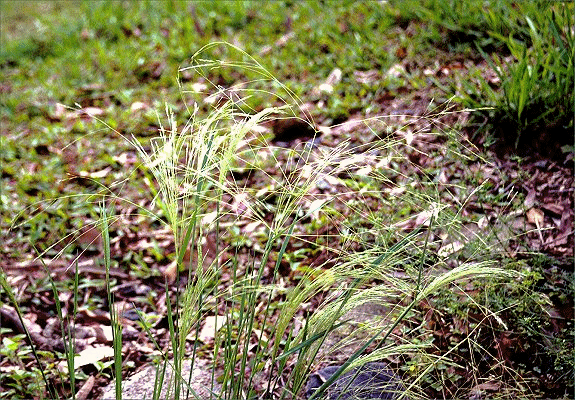 |
 |
|
 |
 |
|

Lachnagrostis filiformis (Forst.)
Trin.
|
Common name
Blown Grass
Fairy Grass
Derivation
Lachnagrostis Trin., Fund. Agrost. 128 (1820); from the Greek
lachnos (wool) and Agrostis. Like Agrostis but lemma hairy
and rhachilla elongated.
avenacea- from the Latin avenaceus (oat-like), referring to the resemblance of the spikelets to the oat genus, Avena
Published in
Telopea 9: 439-438 (2001).
Common synonyms
Agrostis avenacea J.F.Gmel.
Agrostis avenacea J.F.Gmel. var. avenacea
Agrostis avenacea J.F.Gmel. var. perennis Vickery
Agrostis filiformis (Forst.) Spreng.
Habit
Annual or perennial, tufted. Rhizomes short. Culms erect or geniculately ascending,
15–80 cm tall, 4-noded. Mid-culm internodes scaberulous. Mid-culm nodes
brown, glabrous. Leaves mostly basal. Leaf-sheaths scaberulous, glabrous on
surface. Ligule an eciliate membrane, 2–8 mm long, lacerate, obtuse or
acute. Leaf-blades filiform, flat or conduplicate, 8–30 cm long, 1–3.5(–5)
mm wide. Leaf-blade apex acuminate.
Inflorescence
Inflorescence compound, a panicle, exserted. Peduncle antrorsely scabrous above.
Panicle open, obovate, effuse, 10–30 cm long, with spikelets clustered
towards branch tips. Primary panicle branches spreading or drooping, whorled
at most nodes
Spikelets
Spikelets spreading, solitary. Pedicels clavate, 1–5 mm long, scabrous.
Fertile spikelets 1-flowered, comprising 1 fertile floret, without rhachilla
extension, cuneate, laterally compressed, 2–4.5 mm long, breaking up at
maturity. Spikelets disarticulating below each fertile floret. Floret callus
glabrous.
Glumes
Glumes persistent, similar, firmer than fertile lemma, shiny, gaping. Lower
glume lanceolate, 2.3 mm long, 90% length of upper glume, membranous, 1-keeled,
1-nerved, midnerve scabrous. Lower glume lateral nerves absent. Lower glume
apex acute. Upper glume lanceolate, 2.5 mm long, 140% of length of adjacent
fertile lemma, membranous, 1-keeled, 1-nerved, midnerve scabrous. Upper glume
lateral nerves absent. Upper glume apex acute.
Florets
Fertile lemma oblong, 1–3.5 mm long, hyaline, 4–5-nerved. Lemma surface
pubescent or villous. Lemma apex dentate, 4-fid, with simple equal lobes, truncate,
awned. Median (principal) awn dorsal, arising 50–75% way up back of
lemma, geniculate, 3.5–5.5 mm long overall, with a twisted column. Palea
75% of length of lemma, hyaline, 2-nerved. Palea apex dentate, 2-fid. Lodicules
2, membranous. Anthers 3, 0.2–0.5 mm long. Grain with adherent pericarp.
Hilum linear. Endosperm farinose.
Continental Distribution:
Africa, Tropical Asia, Australasia, Pacific, North America, South America.
Australian Distribution :
Western Australia, Northern Territory, South Australia, Queensland, New South
Wales, Victoria, Tasmania.
Western Australia: Giles, Austin, Irwin, Drummond, Dale, Menzies, Warren, Eyre, Avon. Northern Territory: Central Australia South. South Australia: North-western, Lake Eyre, Nullabor, Gairdner-Torrens Basin, Flinders Ranges, Eastern, Eyre Peninsula, Northern Lofty, Murray, Yorke Peninsula, Southern Lofty, Kangaroo Island, South-eastern. Queensland: Burke, South Kennedy, Port Curtis, Leichhardt, Burnett, Wide Bay, Darling Downs, Moreton, Gregory South, Warrego, Maranoa. New South Wales: North Coast, Central Coast, South Coast, Northern Tablelands, Central Tablelands, Southern Tablelands, North-Western Slopes, Central-Western Slopes, North-Western Plains, South-Western Plains, North Far Western Plains, South Far Western Plains. Victoria: Murray Mallee, Lowan Mallee, Wimmera, Wannon, Grampians, Riverina, Midlands, Victorian Volcanic Plain, Otway Plain, Otway Range, Eastern Highlands, Gippsland Plains, Gippsland Highlands, Wilsons Promontory, Snowfields, East Gippsland. Tasmania: Furneaux Group, North West, North East, West Coast, Central Highlands, Midlands, Ben Lomond, East Coast, South West.
Classification. (GPWG
2001):
Pooideae: Aveneae
Notes
Native. Occurring in all States and Territories except the N.T., and on Lord
Howe Is. Widespread, usually in damp sites from sea-level to highland areas,
although rare at higher altitudes. Flowers Sept.–Jan.

Inflorescence (photo)
© D. Sharp